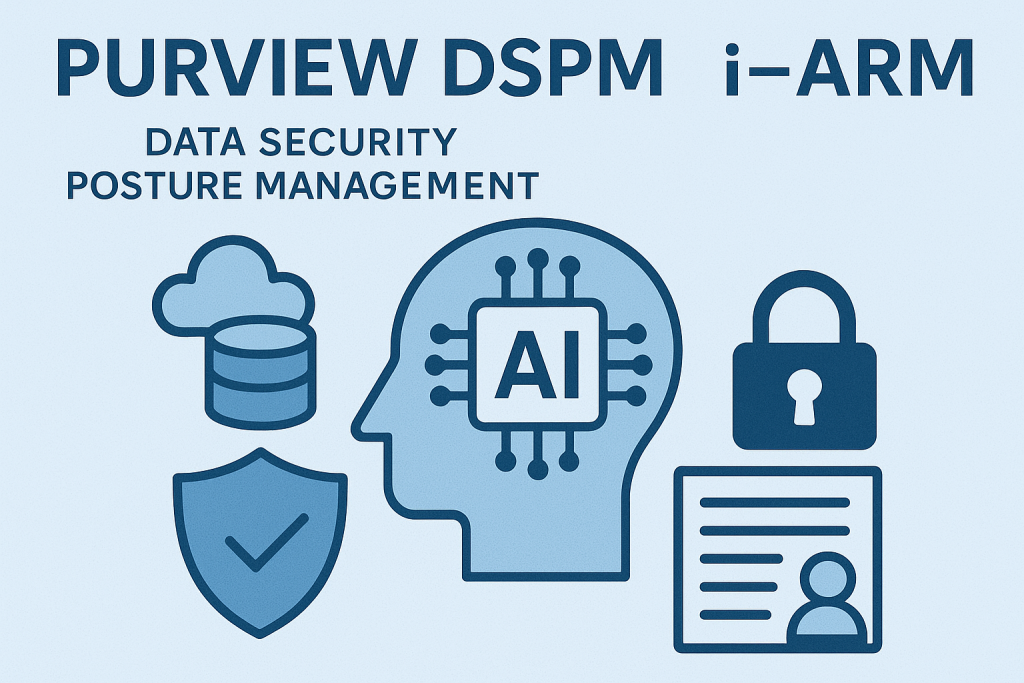![]()
Data security posture management (DSPM) is rapidly becoming essential in a world of multi-cloud environments and AI-assisted workflows. Microsoft Purview DSPM delivers discovery and classification capabilities — but integrating Infotechtion’s i-ARM unlocks greater control, automation, and readiness. In this blog, we explore how i-ARM complements Microsoft Purview DSPM by focusing on advanced classification workflows, remediation automation, and intelligent governance — especially as organizations scale Copilot adoption.

Why DSPM Isn’t Enough on Its Own
Microsoft Purview DSPM gives enterprises the visibility to identify, assess, and understand data risks across multi-cloud and on-prem environments. It is a centralised platform that can provide recommendations on classifying your sensitive data, flags misconfigurations, detects overexposure, and supports AI-readiness initiatives.
But data discovery is only the beginning. Without action, flagged issues remain unresolved. That’s where i-ARM comes in.
i–ARM allows you to:
- Pinpoint areas of risk or immaturity at the department, location, or function level
- Drill into high-risk or overexposed data to understand the who, where, and why
- Identify ROT data — redundant, obsolete, or trivial files — and automate their classification or disposal
This precision is vital for organizations scaling DSPM across complex environments and preparing for advanced use cases like Microsoft Copilot.
What Makes i-ARM a Strategic Extension to DSPM?
i-ARM builds on Microsoft Purview DSPM by enabling organisations to act on data posture insights through automation, analytics, and cross-environment governance. Below are a few examples:
- Provides Unified Log Analytics across DLP, IRM, and MIP to identify Compliance Hotstops and Behavioural Anomalies
How: i-ARM ingests and aggregates telemetry from Microsoft Purview’s audit logs, including events from DLP, IRM and MIP. This produces a unified analytics layer revealing for example, the top violators of DLP policies, files with frequent access overrides or external sharing attempts and high-risk user behaviours e.g. repeated label downgrades.
Integration with DSPM: DSPM focuses on holistic risk posture – it flags potential weaknesses and configuration issues. i-ARM enhances this by providing contextual user level analytics to help triage incidents, map patterns across audit logs to highlight systematic gaps and feeds insights back into DSPM dashboards for action prioritisation. This results in data-driven remediation strategies based on real user behaviour.
Similarly, i-ARM integration with Purview DSPM facilitates enhanced data classification insights and user activity-based remediation actions through the following capabilities:
- External Data Connectors: i-ARM extends Purview’s classification engine (via SIT detection) to external/non-M365 locations and can feed those results back into a unified classification viewpoint. This gives DSPM coverage of the full enterprise data estate, not just Microsoft native workloads.
- Workflows via Microsoft Graph API: i-ARM uses the Microsoft Graph API to read and update Sensitivity and Retention labels. When DSPM alerts to missing, incorrect or overridden labels, i-ARM can automate corrective label application based on classification criteria, extend these actions to files stored in network ir legacy file-shares and use DSPM’s real-time posture signals as workflow triggers for i-ARM automation.
- Central Policy Management across M365 and beyond: i-ARM consolidates governance actions into a single pane of glass; when DSPM highlights a misconfiguration or violation (e.g. sensitive file oversharing), i-ARM provides a central interface to resolve issues at the policy level, trigger follow-up actions tied to DSPM-reported incidents and tracks and reports on response efficacy overtime
Smarter Classification Starts with Smarter Integration
By combining DSPM’s visibility with i-ARM’s remediation and automation, organizations unlock a more mature data governance framework. Classification is no longer siloed — it becomes unified across workloads and file types. AI tools like Copilot can be governed intelligently, without compromising productivity. Risk is not just flagged but contextualised and resolved through actionable workflows.
The result is data strategy that moves beyond reactive monitoring into intelligent, automated goverance across the lifecycle of your most sensitive information.
Ready to turn insight into action? Whether you’re just starting with DSPM or looking to scale your data governance strategy, i-ARM can help you take control. Get in touch at contact@infotechtion.com to speak with one of our experts and see how we can support your organization.



